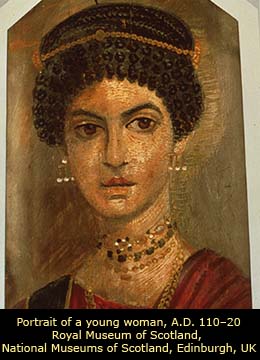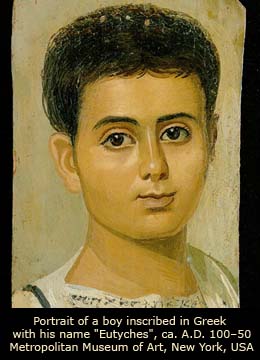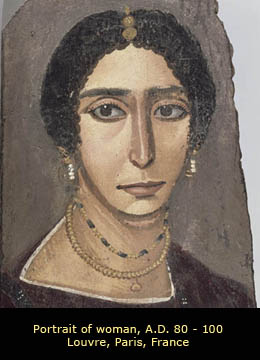Mysterious Fayum Portraits
Ancient Egypt, A.D. 30 - 384
Nobody knows who painted them and nobody is absolutely sure when these beautiful and mysterious portraits first time reached Western Europe. It could be in 1626, when Italian traveler Pietro della Valle brought to Rome mysterious souvenir from his voyage to Saqquara,(1615/1616), the Fayum (fayum in Egyptian means marshland) region in Egypt 70 km south of Cairo, 40 km west of the Nile. His souvenir, a well preserved mummy (now at the Dresden Museum) wrapped in a great quantity of linen cloths looked at him itself, uncannily alive, with his big eyes. Astonished Pietro della Valle could not believe his own eyes. The head of the mummy was covered with an effigy, a wooden portrait of young man nicely and carefully fastened into the linen wrapping. The rest of the mummy was all painted in gold, beautifully stitched, adorned with beats, gold leaves, hieroglyphics, and symbols of Egyptian magic to transport the dead into the afterlife.
It could also be much, much earlier, in the first century when the first description of such a portrait was written in "Histora Naturalis" by Pliny the elder. Today these paintings are known as Fayum, or mummy portraits. The Fayum portraits are the most important portraits which have survived antiquity. Till now around 1000 images of men, women and children beautiful and plain, young and old have been found, all of whom seem mysteriously alive. These portraits were done by well trained artists after the individual's death or during the live of its sitter. Painted on wooden panels or linen shrouds, the portraits were placed over the faces of dead and fastened carefully into the mummy bandages.
During the three centuries between the conquest of Egypt by Alexander the Great in 332 B.C. and fall of the Ptolemies and establishment of Roman rules in 30 B.C., immigrants from different countries continuously increased the population of Fayum, where the year-around climate is warm and the soil very fertile, In the turn of the new Millennium this area of Egypt, was inhibited by Egyptians, Greeks, Syrians, Libyans, Persians, Romans and Jews. In this cosmopolitan society, mixing bowl of various immigrants and their cultures and religions, the intermarriages were common. The various religions blends together, and as a natural consequence the burial practices were the product of a combination of two traditions, that of old pharaonic Egypt and that of Classical World. Thus, the Fayum funeral style is resultat that of Greco-Roman burial style and that of the Egyptian believes in a life after death. The belief in a after death life was one of the most conspicuous features of ancient Egyptians. They believed that each human individual comprised not only a physical body but also from living entities as name and shadow, and three other crucial elements essential to human survival known as the ka, ba and akh. They believed that the death is a temporary interruption of the life and in order to obtain an eternal life some preparation must be done. The process of ensuring any individual's enjoyment of the afterlife requires that all of these separate elements (the body, the akh, ha and ba, the name and the shadow) were sustained and protected from harm. An transfigured spirit of the deceased (akh) has to survive death in both physical and spiritual forms. Thus preservation of the body through mummification plays the major role. it serves as an anchor for the spiritual aspects of life force (the ka) and spirit of mobility (the ba). When any individual died, the ka continued to live so it requires the same substance as a human being enjoyed during the life. For this reason all necessaries have to be provided in the tomb. It could be done by providing the food, drink, amulets, anthropoid coffins, magical inscription, images that could serve in place of the real thing, statues of the gods like god Osiris (Egyptian god of death, resurrection and fertility) or jackal-headed god Anubis (god of dead, closely associated with embalming and mummification), Coffin texts decorated with Egyptian religious symbols and deities such as Thot, Ra, Anubis, Horus, Isis, Osiris and Nephtys, as well as a name of the deceased and the shadow for identification.
In their funeral practices ancient Egyptians did not make much use of portraits of the deceased, relying on and inscription and title instead. It was, however, important for Greeks and Romans to place the painted portrait of the love one in his tomb. These portraits, influenced by the geographical, religious, and burial practices of the Fayum region became regarded by Egyptians as the immortal surrogate (the name and the shadow) of the deceased and have to be protected from harm. Therefore most of the Fayum portraits were executed in the encaustic painting technique as the most durable painting technique introduced by ancient Greeks. The term encaustic is derived from the Greek world "enkaien" and means "to burn into." It is a procedure of applying molten coloured wax to various surfaces like a wooden panel or a linen shroud. Mentioned by Pliny the Elder in his "Historia Naturalis" the painting medium, colored wax, could be obtained by adding the pigments to the hot melted bee-wax or by added pigments mixed with oil and egg to the cold bee-wax and then heated (Punic wax). In his description of encaustic work he also mentioned tools for applying painting medium: the cestrum, the cauterium and the brush which let the artist to model, sculpture and texture the surface of the painting. It can be also polished to the high gloss. The raisin was added to the mixture to harden it and to make the applying process easier.
At the first glance the portraits seem not at all ancient, a little bit damaged, but color is deep and vivid, the surface is glossy,
the faces are expressive, full of human emotions. It is difficult to believe that most of them made from the first to fourth
century AD, are often astonishingly lifelike. These portraits seem to be naturalistic depiction of the sitters.
and always show the image which sitter wants to take into the afterlife.
Occasionally at the request of his commissioner the painter slightly altered the appearance of their subject by embellishing, rejuvenating or refining
the image of the deceased to emphasize or minimize particular qualities of the subject.
Some of the portraits like this one of Greek boy, Eutyches, bears short inscription-identification of the subject, or wishes the deceased a
"safe journey".
However, the majority of the mummy portraits do not provide such inscriptions.
According to the Egyptian tradition the body and wrappings of Egyptian mummies were adorned with gold ornaments, charms, amulets
and mystical texts containing the identification of the deceased. Unfortunately most of the portraits
have been separated from the mummies to which they were attached so we rarely know the identity of the sitter.
The realistic depictions of physical appearance, hairstyles and adornments, garments, jewelry and makeup
of the period provide fascinating information about the deceased, his/her social status,
ethnic group, presumed nationality and indicate the time of death.
The presented here mummy portrait of this young woman from Arsinoë ( encaustic on wood, A.D. 110-120, Royal Museum of Scotland, National Museum of Scotland,
Edinburgh, UK), is one of the fines of those attributed to the necropolis in the Fayum. Her beautiful dark eyes with long lashes are gazing
trustingly into infinity. Her shapely forehead and ears is framed with the lines of small curls.
Woman's hair is braided and wrapped around the top of her head like a cornet, a style fashionable during the reign of the
Emperor Hadrian. To make such elaborate hairstyle the hairpieces and curling tongs were used.
Her face shows a trace of make-up that was worn by young Roman women of the late first century.
Roman women frequently used the white lead (lead carbonate) and chalk for make-up.
The white lead was applied on face especially to give the face an attractive pale complexion, but it was deadly poison.
Many women died unknowingly from lead poisoning after applying this noxious substance.
Also jewellery played significant role in the life of women. Its primary reason was to enhance wearer's natural features.
In this male-dominated society correct appearance of wives and daughters was often a necessary
prerequisite to men' political and economical success.
The central part her hair is adorned with a gold chain composed of slightly flattened links and fixed, probably, with tree ornamented
hairpins.
Her small shapely ears are adorned with long pearl earrings. Her three-chain necklace, probably composed of large pearls,
emeralds, red stones (perhaps carmelin) and sapphires tightly embrace her neck. Her lips are very finely-drawn.
The lady wears an unusual dark red tunic and heavy golden chain. In Egyptian belief red is associated with life and regeneration. The quality of the painting technique, her hair arrangement and adornment,
the richness of her dress, and the lavishness of the lady's jewellery indicates that she died between
117 - 138 AD,
and shows that she belonged to the highly Romanized elite at the time.
The second portrait executed in thickly textured wax, confirms great virtuosity in the Greek tradition of painting. The figure of the boy in the portrait seems to stands out from the olive background, creates an impression of real depth. This effect obtained by masterly manipulation with light and shadow by ancient painter was unknown in traditional Egyptian paintings. The name of the sitter is known and according to the Greek inscription written in dark purple pigment below the neckline of the tunic his name is Eutyches, "son of Herakleides Evandros" or "Herakleides, son of Evandros", (encaustic on wood, Metropolitan Museum of Art, New York, USA). This remarkably lifelike mummy portrait shows extraordinarily vivid but slightly sad face of a young Greek boy who lived in the Fayum region and died sometimes between 193-211 A.D. The young teenage boy calmly looks at the viewer. He is dressed in a white Roman tunic with a narrow purple clavus (a vertical stripe) over the right shoulder. A mantle is draped over the left shoulder. Dark brown hair of hansom boy is short, with locks brushed to both sides of the forehead.
The third portrait shows an woman who lived in the Fayum region and died sometimes between 80 - 100 A.D. (encaustic on wood, Louvre, Paris, France). A mature woman whose name is not known, gazes out from his Romano-Egyptian mummy portrait. The woman, probably in her mid forties, wears a dark purple tunic decorated with a black strips and white border at the neckline. Her face is turned towards the viewer while her bust is turned slightly to the right. Her big dark slightly upturned eyes look not at the viewer but towards the heavens. The woman's hair, covering her ears and framing her slender face, is arranged with a central parting decorated with an ornament composed of three disks. She is also wearing long pearl earrings and two necklaces. X-rays reveal that the original portrait was that of a much older woman with a strongly lined face. The painter, probably at the request of his client who wanted her to take more flattering image into afterlife, subsequently "rejuvenated" the image by shortening her chin and smoothing her skin.
In the collection of more than a thousand portraits excavated from the burial site of Fayum the portraits of Greeks and Romans are presented most frequently. Greeks and Romans were part of the most prosperous elite of administrative officeholders and ruled classes in Roman-ruled Egypt of the beginning of first millennium. They mostly commissioned elaborate mummy portraits of loved ones to assure their safety passage to afterlife existence. We do not know if they reached exclusive destiny with the gods in a celestial afterlife, but surely they reached certain level of immortality. These alluring, realistic, so modern and alive faces from the past make you think, they were portrayed for eternity.


